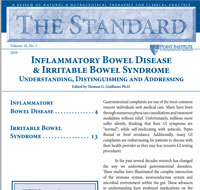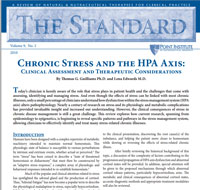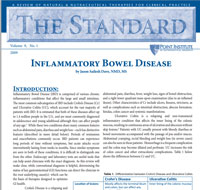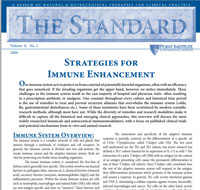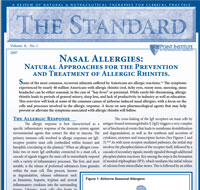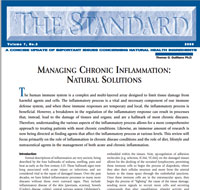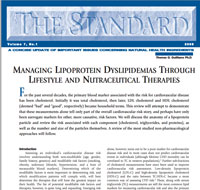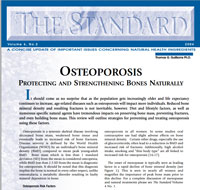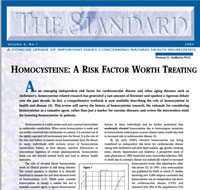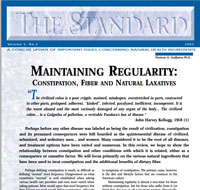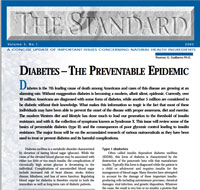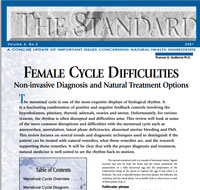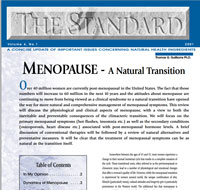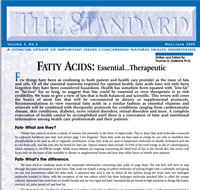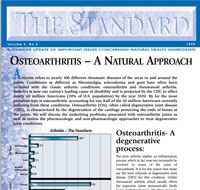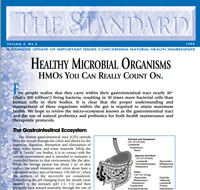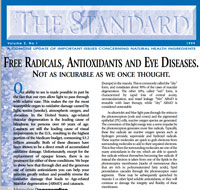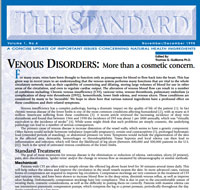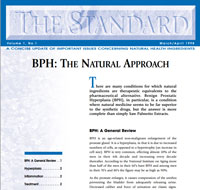You can Download Complimentary Copies of Many of our Archived Monographs as PDFs (Below). Note that these are from 2015 (or older). Please Respect our Copyright and DO NOT UPLOAD THESE PDFs to another website.
To Download More Recent Standard Monographs (for a small fee), please visit our Bookstore.
To Purchase Bundles (0f 25) Print Copies of any of our Monographs, please contact the Lifestyle Matrix Resource Center.
-
Prenatal Nutrition: The Role of Diet and Supplementation (Volume 11, No. 1): A review covering the unique dietary needs and recommendations for pregnant (or soon to be pregnant) women. This covers dietary patterns, macronutrients, vitamins, minerals, key support nutrients and even probiotic recommendations. This discussion covers basic nutrient mechanisms as well as genomic (and epigenetic) influences of nutrients. Also covered are nuances between different forms of supplemental folates, iron and vitamin B12, some of which may be of interest to the clinician making specific recommendations.
-
Inflammatory bowel disease & Irritable bowel syndrome: Understanding, distinguishing and addressing (Volume 10, No. 1): A broad discussion of inflammatory bowel disease (IBD) and irritable bowel syndrome (IBS). Includes etiology and risk factors, lab assessment, and the 4R program. Dietary therapies and nutraceutical treatments are discussed. The role of probiotics, prebiotics, EFAs, curcumin, boswellia, vitamin D and glutamine in IBD, and peppermint oil, probiotics, carminative herbs, fiber, and CAM therapies in IBS are explored.
-
Chronic stress and the HPA axis (Volume 9, No. 2)
A review of the current research behind hypothalamic-pituitary-adrenal axis dysfunction (HPA). Discusses the stress response system, HPA axis dysfunction-related conditions, lab hormone assessment, hyper and hypocortisolism, and natural therapies. Glycemic control and supplementation of nutraceuticals such as DHEA, pregnenolone, phosphatidylserine, and adaptogenic herbs are reviewed. -
Inflammatory bowel disease (Volume 9, No. 1)
Reviews the different type of IBD (Crohn’s and Ulcerative colitis) and their etiology, along with risk factors and lab assessment. Both conventional and complementary medical treatments are discussed, including the 4R program, dietary therapies, and nutraceutical treatments including probiotics, prebiotics, EFAs, curcumin, boswellia, vitamin D and glutamine. -
Strategies for immune enhancement (Volume 8, No. 2)
A discussion of the most widely researched botanicals and nutraceuticals for immune support. Reviews the cells of the immune system, key macro and micronutrients, including vitamin A, vitamin C, and zinc, and nutraceuticals/botanicals: Echinacea, mushroom extracts, andrographis, arabinogalactan, astragalus, probiotics, lactoferrin, bovine colostrum, and more. -
Nasal allergies: Natural approaches for the prevention and treatment of allergic rhinitis (Volume 8, No. 1)
Explores the allergic response mechanism and the common causes of airborne induced nasal allergies. Discusses common allergens and susceptibility, as well as conventional treatments, the role of diet, and key nutraceuticals such as probiotics, quercetin, nettles and natural mucolytics. -
Managing chronic inflammation: Natural solutions (Volume 7, No. 2)
A review of the role of inflammation in chronic disease, including mediators and clinical markers of inflammation. Lifestyle factors such as diet and obesity are discussed, as well as lifestyle interventions including the Mediterranean diet and adequate physical activity. Nutraceutical intervention including fatty acids, turmeric, quercetin, boswellia, and other key botanicals are reviewed. -
Managing lipoprotein dyslipidemias through lifestyle and nutraceutical therapies (Volume 7, No. 1)
Examines the biochemistry of and risk associated with the various forms of cholesterol, triglycerides and proteins, as well as apolipoproteins and VLDL. Includes a review of atherogenic risk assessment, the role of diet, dietary fiber, and nutraceuticals: niacin, pantethine, policosanol, plant sterols, tocotrienols, fish oils, red yeast rice, berberine, guggul, artichoke, garlic and more. -
Osteoporosis: Protecting and strengthening bones naturally (Volume 6, No. 2)
An outline of strategies for preventing and treating osteoporosis. Reviews risk factors, the bone mass lifecycle and nutritional factors, including calcium and phosphorus, magnesium, strontium, and vitamins B, D, and K, phytoestrogens and isoflavones. -
Homocysteine: A risk factor worth treating (Volume 6, No. 1)
A review of homocysteine as an independent risk factor for cardiovascular disease. Includes history, a brief review of methylation, lab values, risk factor assessment, and diet and lifestyle factors, including key nutrients folic acid, B12, B6, TMG, and N-Acetyl Cysteine (NAC). -
Maintaining regularity: Constipation, fiber and natural laxatives (Volume 5, No. 2)
A discussion of constipation and related conditions. Constipation as a risk factor for other diseases, as well as the role of the Western diet are discussed. Natural treatments, including fiber, flax, psyllium husks, and glucomannan, and laxatives such as aloe, cascara sagrada, and senna are explored. -
Diabetes – The preventable epidemic (Volume 5, No. 1)
Reviews of the basics of type 2 diabetes development, syndrome X and insulin resistance. Discusses the importance of diet and lifestyle and key natural treatments, including dietary fiber, chromium, EFAs, vanadium, biotin, alpha lipoic acid, gymnema, bitter melon and fenugreek. -
Female cycle difficulties: Non-invasive diagnosis and treatment options (Volume 4, No. 2)
A review of the menstrual cycle and its common disruptions, including amenorrhea, abnormal uterine bleeding and PMS. Trends and diagnostic techniques are discussed, as are natural treatment options and the data supporting their use. Includes a review of nutrients, including important vitamins and minerals, as well as key botanicals such as vitex and other beneficial alternative treatment approaches. -
Menopause – A natural transition (Volume 4, No. 1)
A review of the physiological and clinical aspects of menopause. Conventional treatment options including hormone replacement therapy (HRT) are examined, as are natural hormone replacement and supportive botanicals such as black cohosh, licorice, chaste tree (vitex) and dong quai, and phytoestrogens. The misconception of menopause as an estrogen deficiency disease and the role of progesterone are also discussed. -
Fatty acids: Essential…therapeutic (Volume 3, No.2)
Answers the most common questions about the role of fat and its different forms in human health. Essential fatty acids, omega 3 and omega 6 are discussed, as well as the therapeutic use of omega 3 in cardiometabolic disease (cardiovascular disease and diabetes), as well as inflammatory and autoimmune diseases. The pros and cons of flax as a source of omega 3, as well as the role of GLA-rich oils (including borage and evening primrose) and conjugated linoleic acid (CLA) are also explored. -
Osteoarthritis – A natural approach (Volume 2, No. 3)
An examination of the degenerative process of osteoarthritis, and conventional and natural treatment options for the condition. The data supporting use of the various forms of glucosamine and chondroitin sulfate are reviewed, as well as research on sulfur-containing supplements such as SAMe and DMSO. Additional key vitamins, minerals and botanicals are also discussed. -
Healthy microbial organisms: HMOs you can really count on (Volume 2, No. 2)
A review of the gastrointestinal ecosystem and its key microbial inhabitants, including lactobacillus and bifidobacteria. Discusses the health benefits associated with probiotic and prebiotic use in conditions such as dysbiosis. The anti-microbial activity and immune enhancing properties of probiotics are also reviewed. -
Free radicals, antioxidants and eye diseases: Not as incurable as we once thought (Volume 2, No. 1)
A review of the most common eye diseases in the U.S., including age-related macular degeneration (AMD) and cataracts, and their mechanisms. Includes a discussion of natural ingredients which help in prevention, including antioxidant support supplements, alpha lipoic acid, glutathione and ginkgo biloba, as well as carotenoids, flavonoids and the role of diet. -
Venous disorders: More than a cosmetic concern (Volume 1, No. 4)
A re-examination of the important role of the venous system to the body’s circulation. Discusses conditions resulting from the alteration of proper venous flow, including chronic venous insufficiency (CVI), varicose veins, venous thrombosis, pulmonary embolism, deep vein thrombosis (DVI)), hemorrhoids, and venous ulcers, which are commonly considered incurable, along with the natural ingredients that can help improve these conditions and their symptoms, such as horse chestnut and butcher’s broom. -
BPH (Volume 1, No. 1)
A review of the data on benign prostatic hyperplasia (BPH). The paper examines hyperplasia and prostatitis, conventional treatment options for BPH and options for a natural approach to treatment, including diet, nutrients and plant-based supplements. Specific topics include saw palmetto, pygeum, nettles, and zinc.



